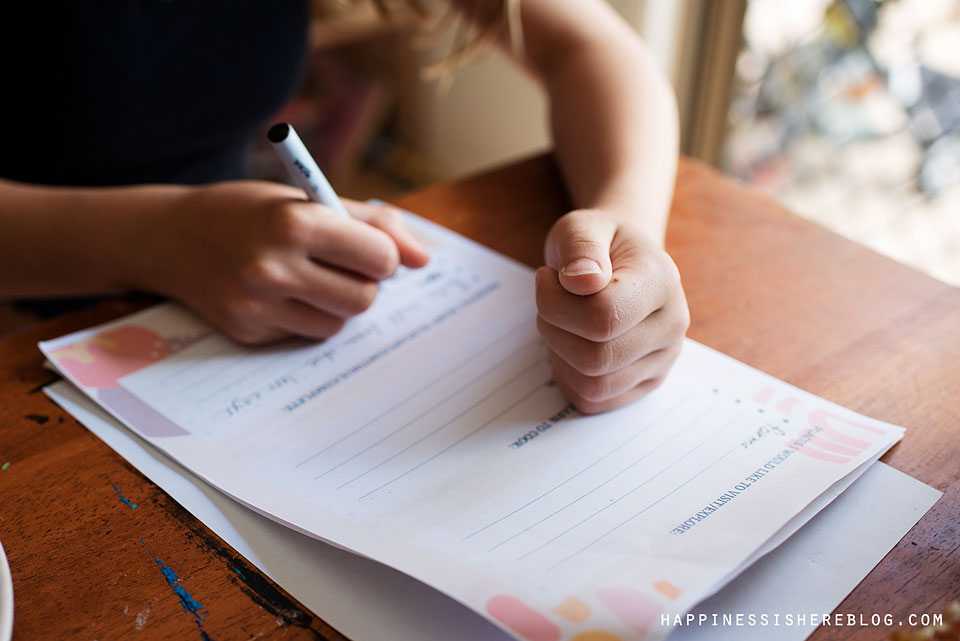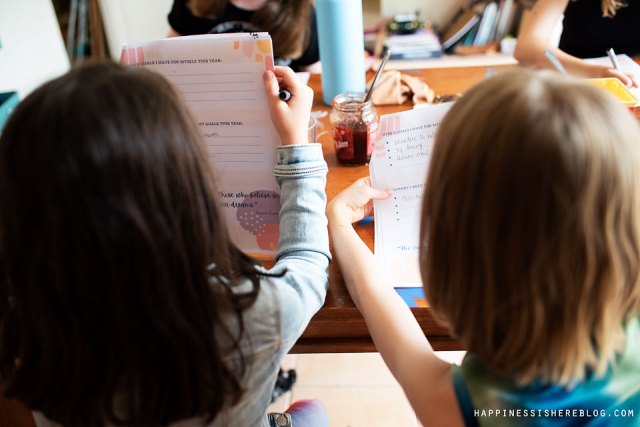
Identifying Interests and Setting Goals in an Unschooling Home
This post contains affiliate links
The holiday period is over, we’ve had a long break, and now the possibilities of a new year are creeping into our mind. I just love a fresh new year!

We recently sat down to chat about what we wanted our year ahead to look like, and I wanted to share what that process looked like for us. Just because we unschool does not mean we cannot plan, or have any structure in our life. That’s a myth! There are no rules about what you can and can’t do, only that it is a collaborative, consensual process of working out what best fits your family.
For us, we like a plan. We feel best having familiarity and rhythm to our days and weeks, and we enjoy having goals and projects and thinking about the things we would like to experience/learn about/achieve.
Making time to sit down with my kids and talk about what they’re currently interested in, what they want to make more time for, what projects they’d like to start/finish, and how they want their days to look also really helps me as an unschooling parent. It’s my job to support their learning, so regular check-ins are a must for helping them achieve their goals. It also helps me work out what resources we might need, what excursions I should plan, and what they need from me day to day.
All this to say, I’m a big fan of planning! So how do we do it?
Prepare some questions

If you ask your kids ‘what do you want to do this year?’ you might be met with a blank stare, a shrug, or an ‘I don’t know’. That’s a big open question with so many answers and it can be hard for them to narrow down what they want to do. Instead, prepare some specific questions that will help them get their ideas in order.
Some examples:
- What are your current interests?
- What would you like to make more time for?
- What skills would you like to practice?
- What courses or activities would you like to try?
- Where would you like to visit?
- What books would you like to read?
I’ve shared the complete printable list of questions I used with my children at the end of this post for you to download. You can use them as is, or take inspiration from them and adapt to your family. You might add some questions, or ask a lot less! It’s actually a pretty long list of questions, which suits us but might not suit everyone. A couple of the girls here are keen planners and love this kind of thing, and they’ve also been doing similar for years so it’s a familiar process.
I printed these pages out and gave a copy to each of the older girls (aged 13 and 11) to fill out. For the younger ones (aged 9 and 7) I asked the questions and wrote down their answers for them. You might need to change the wording for younger children as I did when I read, or give examples of what you mean. After the older girls had finished they also showed me their answers and I helped them with any they hadn’t answered or reminded them of things I knew they were working on but had forgotten, etc.

Give them time
Don’t expect them to sit down and answer all the questions in one go! Give the questionnaire to your children at least a few days before you plan to discuss their goals. It takes time to remember everything and come up with ideas. Let them read the questions and sit on them for a while, adding to their answers throughout the week as they remember all the things they are keen to do. I let my kids know a few days before I gave them the questions that soon we would have a chat about the year ahead so they should start thinking about any plans they had. Then I gave them the questions and left it a few more days until we came together to chat.
Call a meeting

Once everyone has had plenty of time to think about their answers, and you feel they’re in the right mood to sit down and chat, it’s family meeting time! I used to talk to the kids one on one about their plans but now we do a bit of both instead. I help them with answering their questions, and then we all come together to talk about them. I think it’s so nice to all sit down together and chat and hear from everyone what they’re interested in. They are always interested in what the others are doing and it’s really connecting to plan together. We are a team and it feels exciting to plan a fun and inspiring year together!
Make it special! Bake a special treat, have some juice or hot chocolate, use the fancy plates, light a candle. Make the meeting an event to look forward to. This year Miss 13 cooked some pikelets and everyone shared them while we talked.
First up, I gave everyone my little spiel on the point of the meeting and how I thought it should go. Basically, that it was time to talk about all the things people wanted to do this year and work together to come up with a plan of how to make sure we fit all the important stuff they wanted to do in our week. They were happy with that.
Go through the questions

Next, we went through the questions they had answered one by one and everyone read out their answers. As we were talking people remembered other things they wanted to do, and added them to their lists. While I listened I kept track of anything that came up regularly and wrote it down. We had a lot of mutual interests come up e.g. cooking, acro, kayaking, reading, and writing. I wanted to keep track of them so that we could remember that we needed to make specific times in our week for people to do these together (interests/projects that only one person is into happen in project time). I also jotted down daily habits they all listed (e.g. morning walks and reading before bed), and places they wanted to visit this year.
Plan your daily rhythm
After we had talked about everyone’s interests and goals, it was time to work out how to fit it all into our week. I asked the girls what they wanted their days to look like and wrote down all the things they said they wanted to include in no particular order, e.g. read aloud time, project time, morning walks, dance/acro practice, etc. Then we looked at any interests they shared and when we could fit them in, e.g. kayaking on the weekends with Dad.

Next, we talked about what order we would do these things in, and any changes that needed to be made from how we usually do some of the regular things. For example, the girls all wanted to keep read-aloud time in the morning but one of them is not as keen as the others, so we problem-solved how we could make it work for her. We came up with doing read-alouds over breakfast, and sorting through our books and letting her choose her favourites so that I could read them first up and she could leave after that. There were a few other instances like that we also had to work through.
Our goal is always to make sure we find space for everything that’s important to everyone but, also in a way that everyone can enjoy and at a time that works best. Usually, this can be worked out even if a little compromise is needed. No one is ever required to join in with anything that they don’t want to, but what is often the case is that they do want to but the way we are doing it needs to be changed a little to suit everyone as needs change, e.g. people who need to move their bodies more need to be busy doing something while they listen to books, and have less patience for sitting so need their favourite books read first.
Write it down
After we’ve worked out our plan for our days we’re pretty much done, and the last thing to do is write it down. I’m still loving my Mulberry Planner (you can read more about how I use it for planning and recording learning here), so I use pages from that to keep a list of current interests, a list of resources, and our rhythm on the wall in the ‘craft room’.

We find it really helpful to have these on the wall to remind us of our plans. Sometimes it’s a case of out of sight, out of mind. Having projects, skills they want to practice, and resources on the wall in plain sight means when it comes to project time or any time they’re just looking for something to do they can glance at the wall and see what the options are. I’ve also got the daily rhythm that we’re trying out up there, and a place to write questions they don’t want to forget to find the answers to! There’s also a calendar of the year where I will write significant things happening each month, mainly to do with our homeschool group e.g. if there’s a book club or project fair coming up they can see it there and know when they have to start getting ready for it. It’s not there yet, but I’ll also stick up a calendar for the current month with more detail of all the things we’re doing, and a weekly schedule for their dance/acro classes. This wall is in what they call the ‘craft room’, where they spend most of their time creating.
Some of these pages are not usually available with Mulberry Planner as they were made specifically for Happiness is here readers! If you’re interested in getting the planner yourself, and also want these bonus pages, be sure to follow this link or one of the other links in this post and they will be emailed to you automatically.
More tools to track goals

Another couple of pages I love from Mulberry planner are the habit tracking and skill development pages. They tie in nicely with some of my questions, and my kids just love a checklist! It’s a great visual reminder for them. I print out one (or more) of these for each of them and they can keep them in a book, or stick them on their wall and tick off all the days they practice the things they planned. For them this year there’s a lot of acro practice and cooking happening!
Repeat the process
And that’s pretty much it! We have planned for the coming months and usually this gets everyone feeling pretty excited and keen to get started on things. You don’t have to save this process for the beginning of each year either. Do it whenever things are feeling stale and you think it’s time to have a chat about your days, when current interests are no longer exciting, or when your days feel like they aren’t flowing well. It’s a great reset and chance to talk and check in with everyone about their needs and goals. We end up doing this about three times a year.
Some more tips
Give some suggestions
You are part of the family too. How do you want your days to look? What works best for you? You also get a say! For example, this year one of my suggestions was that the kids take turns cooking dinner one day a week so they could learn more recipes they can cook independently, as I think this is an important skill. They were all on board with this. I also asked that on Sundays we schedule some time to talk about what they plan to do that week because it’s easier for me if they lock in days where they plan to use the sewing machine or they want to use the kitchen at project time, etc. It’s difficult if everyone decides they want to cook something on the same day for example. They also thought this was a good idea and have named Sunday ‘dibs day’, haha.
All interests count
All interests and ideas should be taken into consideration. This is not just about planning ‘learning’. Unschooling is a lifestyle and it’s about planning how you will spend your time. Planning for fun and enjoyment! And don’t forget there is learning in everything they do.
This year the girls have again asked me to set up activities for them every morning (I slacked off with this in the second half of the year and they’re keen to restart), requested a specific time for reading and writing practice, and the older girls even wanted to schedule in time in the week to do a maths workbook we started last year. But, they also have goals like: get my back walkover, have more sleepovers with friends, go to the movies with a friend, enter a fun run, go kayaking more often, and make and decorate a 3-tier cake. These are not less valuable! Make sure you’re treating all interests with the same amount of importance and finding time for all of them.
Ask how you can help

I really liked this question and the answers I got. From needing reminders to do things, to requesting tips for using sharp knives when cooking. Don’t expect them to tell you everything they need you to do. Learning how to support them in their learning means knowing your children and observing what they like and don’t like. But, simply asking is a good idea too. It provides an opportunity for them to tell you things you might not have realised, and conveys that you want to help and that you’re a team.
And that’s how we plan! Some questions, a yummy snack, and a chat. It’s not super complicated but I find it very valuable. I hope it’s been helpful to you!
You can download the planning questions for your children below:






Comments
We totally do this, but I like your sheet more than the plain paper! Thanks for making it so pretty. 😉 I LOOOOOOVE planning too. Cheers to the New Year, plans + checklists.
Thank you!
Love all this! My kids struggle to find projects to work on. Do you have a list of projects your kids have done or want to do? Thank you!
I don’t! Off the top of my head: designing and sewing a dress, making a stop motion movie, starting a garden, making salves etc from medicinal herbs, making macrames to sell online, mosaic, writing short stories, lots of art projects, etc
The ability to self-direct has to be one of the biggest positives about home schooling or unschooling. A bit like a Montessori school, but with even more control. It is such a powerful life lesson that you can control your own learning and your own activities
Hi! Lovely article-thank you! My daughters also love it when I have an activity set up for them in the morning-but I just run out of ideas 😉 Do you list anywhere some of the activities you set up for yours? Thanks so much!🥰